Pre Tied Size 8 Trout Hook And Correct Way To Rig Them?
The 9 Most Important Trout Rigs (With Pictures)
UPDATED 07 NOVEMBER 2021
past Pecker Laney
Using the right rig is essential for catching trout successfully, and knowing which rig to use for what conditions tin can brand the departure betwixt communicable your limit or getting skunked.
There's a perfect trout rig for most any situation you lot tin imagine, and that'south why it'southward then important to master rigging for trout, as this will let you to choose exactly the right rig for your specific purposes.
In this article we'll cover the 9 best trout rigs, and will discuss what each of them is ideally suited for.

How do you rig for trout?
If yous want to rig for trout, y'all need to choose 1 of iii basic types of setups:
- Rigs that present your bait suspended underneath a bobber or bladder
- Rigs that present your bait close to the bottom with a weight
- Rigs that enable y'all to cast and actively retrieve an artificial lure
While these iii types of rigs cover almost all trout fishing applications, they come in a variety of different shapes and forms, each of which is all-time suited for slightly different applications. And so if you're a beginner, chances are that you're confused about all the different options of rigging for trout.
However, the great thing is that you can become started with just two or three of the most versatile trout rigs, and and so add more specialized ones once y'all know what kind or setup works all-time for your pond, lake or stream.
Now allow's await at each of the most important trout rigs in more detail, to help you choose the best ane for your purposes.
Meet also: How to find trout line-fishing near me
Bobber rigs for trout
Bobber rigs are amid the most effective trout fishing setups, and piece of work especially well in shallow ponds and streams, too every bit in shallow bays of bigger lakes, and basically in any situation where trout are agile close to the water surface.
Now let's wait at the two main types of bobber rigging for trout.
Trout rig with fixed bobber
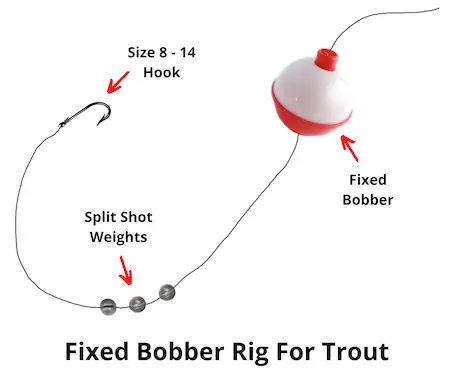
This is one of the simplest trout rigs, and consists of a fixed bobber attached to the line, as well every bit a hook and sinker to weigh down the baited hook in the water. The depth at which the bait is presented depends on the distance between the hook and the bobber.
How to necktie it: Attach the bobber to the line, and then necktie the end of the line to the claw. The most mutual type of bobber used for this rig is a circular red and white bobber, merely yous may want to choose a pencil shaped bobber instead, which offers less resistance when a trout takes the bait.
See likewise: What line-fishing line should you use for trout?
When to use information technology: This is a great rig to use in shallow ponds and streams, as well as any situations where trout are feeding close to the surface. It'southward very piece of cake to set up and a lot of fun to fish with, which makes it an excellent pick for a beginner fishing on a stocked pond. But go on in mind that the maximum depth y'all tin fish corresponds to the length of your rod, since y'all tin can't cast the rig effectively if you set the bobber college than that.
How to use it: The all-time way to fish this rig is to cast information technology out with a baited claw and await for a trout to bite, which is indicated by the bobber being pulled downwardly underwater. When you see this, prepare the hook immediately, so the trout doesn't have a take chances to spit out the hook when it feels resistance on the line. This setup is especially useful in streams and rivers, where yous can use it to drift your allurement into the all-time trout holding locations.
Meet as well: What is the best rod for trout line-fishing?
Slip bobber rig for trout
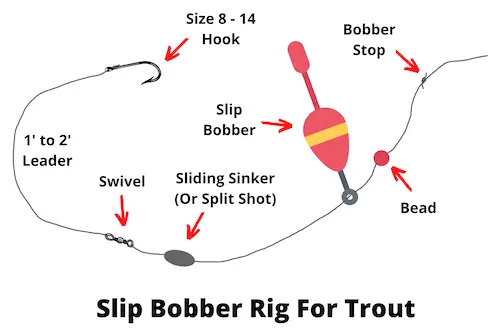
This is another ordinarily used trout rig, and should be part of every trout angler's arsenal of tools. Using a slip bobber makes the rig more compact and easier to cast with than a fixed bobber rig.
How to tie it: Necktie a bobber stop on to your main line, then thread the line through your bobber and tie the line to the hook. The all-time hook size depends on your bait, but generally lies somewhere between size eight and 14.
Run across also: Best size hook for trout
Adhere a split shot or two to the line between the bobber and the hook. This stops the bobber from sliding down onto the claw and it also weighs down your bait, helping to present it at the right depth to the trout. Go on in mind that some baits (like powerbait) float in the water, and yous may need to add together extra split shots to make the baited hook sink down to the desired depth.
When to use it: The sideslip bobber rig is the best choice when trout are feeding in midwater, and you lot can't achieve them with either a stock-still bobber rig or with a bottom fishing rig. The great thing is that you can fish practically any depth with this rig, as you merely need to move the bobber finish up the line to any depth you want to set the bobber.
How to use it: Estimate the depth of the water you lot want to fish in, and fix the bobber end to that depth. Then bait your hook and cast out your rig to the desired spot and wait for a fish to grab the bait.
See as well: How to rig for trout in lakes
Lesser angling rigs for trout
Lesser line-fishing rigs are often the best selection when trout are found in deeper water, as they tend to feed shut to the bottom nearly of the time. At that place are several options available to you lot in this category, so now permit'south look at the most important ones.
Slip sinker rig for trout

This is the simplest bottom fishing rig around, and is the 1 most often taught to novice trout anglers. It has been in use for more than a century, and continues to perform well in many situations where trout concord close to the lesser.
How to tie information technology: Thread a i/viii or i/4 oz sliding sinker (either a bullet or egg sinker) onto your main line, and and then tie the line to a barrel hinge. Attach a leader to the other end of the swivel, and tie your hook to the leader. Choose the blazon and size of claw depending on the blazon of bait you want to use.
When to employ it: Nearly usually used in lakes where trout hold in water deeper than five or 10 feet. It's a great rig to use from shore, since you tin can cast it relatively far, and comprehend a lot of water with information technology. It's important to use this rig with floating bait, since you don't want your baited hook lying on the bottom where trout won't notice information technology. You tin can utilize it with either powerbait (which is designed to float), or worms injected with air to make them float.
How to use it: This is the most common allurement rig used for trout line-fishing, and is ordinarily fished passively. Most anglers cast it out to a promising spot and then expect for a bite. If you do this, brand sure to check it regularly to see if the bait is still on the hook, and also test different spots.
Come across also: Lindy rigging 101
Carolina rig for trout
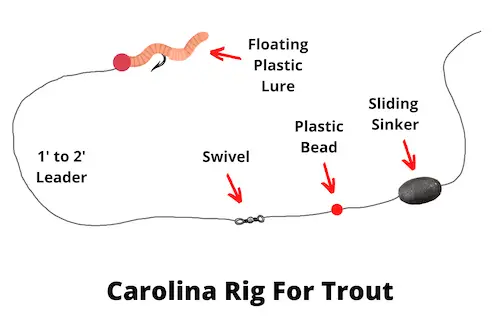
This setup is very similar to the skid sinker rig, only unlike the slip sinker setup information technology is often fished actively with artificial lures instead of passively with allurement, which is why we list the two options separately.
How to necktie it: Start by threading your main line through a one/8 to ane/4 oz sliding sinker. Adjacent, thread the line through a plastic dewdrop, and then tie it to a swivel or snap hinge. The dewdrop stops the weight from banging into the swivel during retrieval, which protects the knot on the swivel from being damaged, and this is more of import if you want to fish it actively.
When to utilise it: Y'all can apply this option anywhere where trout are feeding close to the lesser. It's a bully option to use in lakes, reservoirs and ponds, but yous can besides use it in rivers.
How to utilise it: While you tin can besides use this rig with a baited hook and fish it passively until a trout comes by and bites, the strength of the Carolina rig for trout lies in line-fishing it actively with a floating lure. You lot can use a floating jig head with plastic lures such as trout magnets or ability worms. Subsequently casting out, permit information technology sink to the lesser, and then slowly recollect it with a jigging movement.
Meet besides: How to taxidermy a trout
Separate shot rig for trout
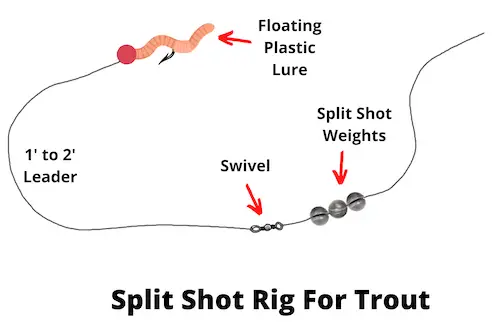
This is basically a finesse version of the Carolina rig, and instead of a sliding sinker it uses 1 or more dissever shots attached to the line. Since trout can be choosy at times (especially in heavily fished waters), it'due south e'er great to have some finesse techniques upwards your sleeve.
How to tie it: Tie your main line to a swivel or snap swivel, and then add one or 2 split shots to the line right above the swivel. Side by side, necktie a 1 to ii foot long fluorocarbon leader to the swivel, and then tie your hook to the other terminate of the leader. Side by side, thread a soft plastic lure onto the claw, and you lot're gear up to kickoff fishing. In most cases yous'll desire to use a floating lure, which will result in presenting your lure right in the strike zone every fourth dimension the dissever shots sink to the lesser.
When to utilise it: This is a great choice if you notice that the trout are being choosy. This is almost oft the case in heavily fished waters, and specially in clear water information technology tin be advantageous to use a finesse rig that's harder for the fish to spot. It's also a great option for trout fishing in small creeks.
How to use it: Bandage it out and let it sink to the bottom. Then slowly remember it with jigging movements of your rod tip. The main disadvantage of the split shot rig is that it can't exist cast as far as the Carolina rig, since it comes with less weight on the line. Because of this, it's better to use information technology in smaller lakes, rivers and streams.
Run into as well: How to rig for trout in rivers and streams
Driblet shot rig for trout
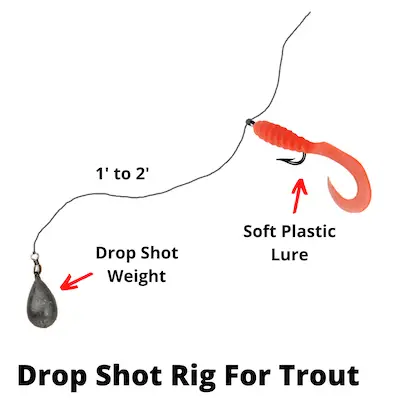
This is some other great bottom fishing rig for trout, and one of it's primal advantages is that it allows you to place your lure in the strike zone and go along it there for a long fourth dimension. Like to the two previous setups, information technology'south most often used with soft plastic lures.
How to tie it: Start by tying your primary line to a 4 or 5 foot fluorocarbon leader with a double uni knot, and then necktie the end of your leader to a 1/8 to i/4 drop shot weight. Side by side, take a allurement hook and identify it facing upwards, and form a loop with the leader line about ane foot in a higher place the drib shot weight. Pass the loop through the eye of the hook from below, and then tie an overhand knot with the loop. Finally, pass the hook through the loop, wet the line, and pull tight.
When to use it: While the drop shot rig was originally developed for vertical angling in deep water from a boat, most bass anglers can tell you that it works equally well for casting from shore, and can even be fished in very shallow water. It'south a great option to apply in lakes and rivers when trout are feeding close to the bottom.
How to use it: Cast it out and slowly call back it by hopping the weight along the bottom, while jigging the lure up and downward. If you lot figure out where the strike zone is, y'all can keep the drop shot rig in place in that location, and simply jerk the lure in place without moving the weight. That way you lot tin can go along your lure correct in front of the fish for a long time, without having to think information technology and cast over again.
See also: Trout spinning rod setup
Lure rigs for trout
While all of the rigs discussed above can be used either with a natural allurement or with an artificial lure, some options of rigging for trout are only intended to exist used with lures. Allow's take a expect at the most important setups that you lot should know.
Spinner rig for trout
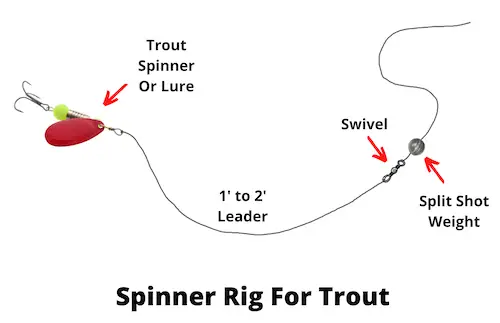
The spinner rig is the most commonly used lure rig for trout. It is most often used with spinners (such every bit a rooster tail or panther martin), only it can also be used with any other artificial lure designed for casting and retrieving.
How to necktie it: Tie your primary line to a swivel or snap hinge, and add one or two separate shot weights only to a higher place the swivel. Next, tie a 2 to iv foot fluorocarbon leader to the other eye of the hinge, then necktie your lure to the other end of the leader. Depending on the size and weight of your lure, adjust the number of split shots to accomplish the right depth during retrieval. The swivel prevents line twist of your master line, merely if you're using a lure that doesn't generate twist, you lot can also necktie the main line straight to the leader.
When to employ it: This is i of the most versatile trout rigs, and can be used in almost any setting, from minor streams to deep lakes. In near cases yous should attempt to fish in the center of the water cavalcade, only can also become deeper than that if the trout are holding shut to the lesser.
How to use it: Simply bandage out the rig and start retrieving. Depending on how deep you want to fish it, you can adjust your remember speed, and y'all tin can too experiment with letting information technology sink to the bottom earlier yous starting time reeling it in. However, if y'all're fishing over weed beds, make sure to keep your lure above the weeds.
See also: Complete guide to trout fishing with spinners
Trout rig with bobber and jig
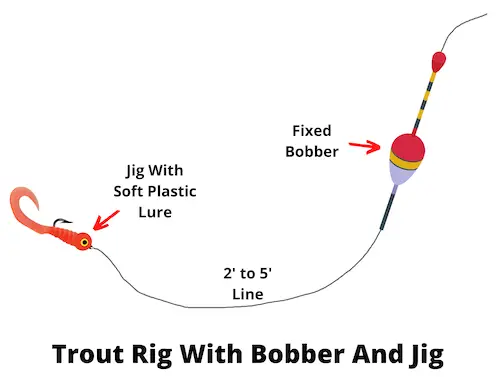
This is a not bad trout rig to use if you're fishing over weeds, every bit you can fish information technology slowly without getting the jig snagged in the weeds.
How to tie it: Depending on the depth of the water, y'all tin use either a fixed bobber or a slip bobber. So start past setting upward one of these ii bobber rigs, and instead of tying a bait hook to the end of the line, tie a 1/16 or ane/8 oz jig head to the end of the line. Next, you can bait the jig caput with whatever of a wide variety of plastic lures, and you're good to become.
When to use it: This is a smashing selection to use whenever you're fishing over weed beds, and desire to keep your lure simply above the weeds. Y'all can achieve this past setting exactly the right depth with your bobber. This trout rig is also peachy for drift angling in streams and rivers, and again you can adjust the setting of your bobber to nowadays the lure just in a higher place the lesser.
How to utilize information technology: If you're angling in a lake, cast out the rig and allow the jig sink every bit far as it can (at which point the bobber stands up straight). Then lift your rod tip to recall the rig nearly 4 to 5 feet, and so pause to allow the jig sink downwardly over again. What this fashion of fishing achieves is that your jig will exist slowly pulled up and so allowed to sink again. In the instance of a plastic worm, this results in the worm wiggling through the water, which is highly attractive to most trout.
See also: How exercise yous rig for trolling trout?
Ned rig for trout
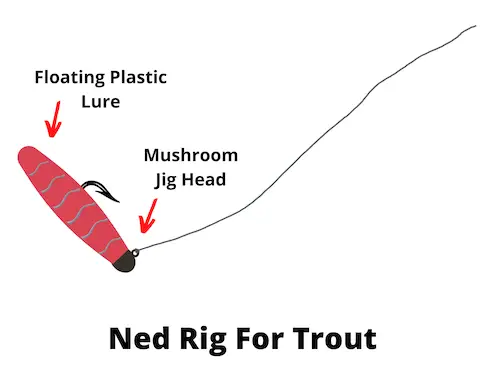
The ned rig is well-nigh familiar to bass anglers, just few people know that it also works really well for catching trout. The primal characteristic of the ned rig that makes it so effective for trout is that information technology is usually fished with a floating plastic tail, which is platonic for trout.
How to necktie it: This is the simplest rig to tie in this collection. If you're using fluorocarbon as your chief line, you can tie that straight to the mushroom jig head of the ned rig and you lot're skilful to go. If you're using braided line as your main line, it's best to use a 2 to iv foot fluorocarbon leader, since that'south much less visible in the water.
When to use it: You can utilize this whenever trout are feeding shut to the bottom, and it works equally well in lakes, rivers, and streams. The merely situation when you lot shouldn't use it is if there's a lot of vegetation on the bottom, which is likely to get your ned rig snagged.
How to utilise it: Bandage it out and let it sink to the bottom, then recall it for three or 4 feet with a jigging motility, and let it settle on the the bottom again. Repeat this until you lot get a bite.
What are the best rigs for trout?
Here are the height 3 all-time rigs for trout that can be used to grab trout nigh anywhere:
- Skid bobber rig
- Slip sinker rig
- Spinner rig
Betwixt them, these three setups embrace all the three principal types of rigging for trout, and if yous can fix them upward and fish them effectively, you're off to a great start. The slip sinker rig is perfect for presenting a allurement close to the bottom, which is the best depth to target trout in well-nigh situations.
The skid bobber rig, on the other hand, can be used to present a bait suspended underneath a bobber, which is groovy when trout are active higher in the water cavalcade. And the spinner rig is a great basic setup for fishing lures actively, which is an platonic fashion to cover a lots of water in search of hungry trout.
See besides: How do you fish for trout at night?
What are the all-time bait rigs for trout?
The acme three best bait rigs for trout are:
- Slip sinker rig
- Skid bobber rig
- Stock-still bobber rig
Each of these rigs is well suited for baiting your hook with natural baits like worms, maggots, minnows, corn, salmon eggs, or scented baits like powerbait. In addition, all of them tin can be used to fish passively, by casting out your rig and so waiting for a trout to pass past and take the bait.
Worm rigs for trout
The best trout rigging to use with worms is either the slip sinker rig, or the slip bobber rig. The quondam is the ideal choice if you know that trout are feeding close to the bottom, and the latter is better if trout are feeding college in the water column.
When using a sideslip sinker with a worm as bait, information technology's important to make sure that your baited hook floats in the h2o, as trout will not eat it if it's lying directly on the bottom. Traditionally, this has been done by injecting air into the worm with a worm syringe (which you can get in virtually tackle shops).
More recently, many anglers are using floating jig heads baited with worms to brand their allurement presentation bladder in the water, and another great trick is to put a pocket-sized marshmallow on the tip of your hook, which also makes it buoyant.
Finally, no affair which worm rig you use for trout, it's ordinarily best not to utilize a whole nightcrawler on your hook, as this is too big to fit into the mouth of a trout. Instead, cut off a ane or ii inch piece of the worm, and thread it onto the claw. The best claw type to use for this is a baitkeeper hook, which prevents the worm from sliding downward the shank of the hook.
Run into also: The best float fishing rigs for steelhead
Minnow rigs for trout
The best trout rigging to use with minnows is either the slip bobber rig, or the fixed bobber rig. Your claw size should exist between size 8 and 12 (depending on the size of the minnow). The all-time way to claw a minnow for trout is through the upper lip.
Small fish class a large part of the nutrition of many trout species, which is why they tin be such a adept allurement. Bobber rigs are great for fishing with live minnows, since you lot can easily spot a trout bite when the bobber goes down, and this allows you to delay your hook gear up long enough to give the trout a little extra time to get the minnow fully within its mouth.
Which i of the two bobber rigs yous choose depends on the depth of the h2o you want to fish in, and on the depth at which trout are active. When using live minnows as trout allurement, it's important to weigh them downward with separate shots, so they stay at the right depth.
Salmon egg rig for trout
The best trout rigging to apply with salmon eggs is 1 of the post-obit options:
- Slip bobber rig
- Stock-still bobber rig
- Drib shot rig
Your hook size should be betwixt size 8 and 14, and if you lot utilize a larger claw, you tin can thread several salmon eggs onto the claw. No matter which rig you cull, you need to cast very gently in order to avoid ripping the eggs off the hook during the casting procedure.
If you lot're fishing in a lake or swimming, the all-time choice is a bobber rig, as that allows y'all to present the salmon eggs suspended in the h2o. If you're fishing in a stream or river, you can use a bobber rig to drift the salmon eggs with the electric current.
Alternatively, you can also use a carve up shot rig to drift the salmon eggs right on top of the bottom of the stream. The latter approach is meliorate for getting it right in front end of the trout, but it's harder to detect bites.
See also: Steelhead bead line-fishing
Final remarks
This concludes our article on rigging for trout, and hopefully we've helped you lot find exactly the right option for your purposes.
Different trout rigs are ideally suited for unlike line-fishing tactics – bait line-fishing, lure fishing, fishing from shore, fishing from a boat, also as line-fishing in diverse bodies of water, ranging from small streams to large lakes.
At present that y'all understand the basics of what each rig is designed for, this should assist you to choose two or iii of them that tin can help yous to catch more than fish in your local trout fishery.
Additional resource:
- How do you rig for steelhead bank line-fishing?
- Complete guide to trout line-fishing from shore
- The all-time lake trout rigs
Pre Tied Size 8 Trout Hook And Correct Way To Rig Them?,
Source: https://sportfishingbuddy.com/rigging-for-trout/
Posted by: coopertives1980.blogspot.com


0 Response to "Pre Tied Size 8 Trout Hook And Correct Way To Rig Them?"
Post a Comment